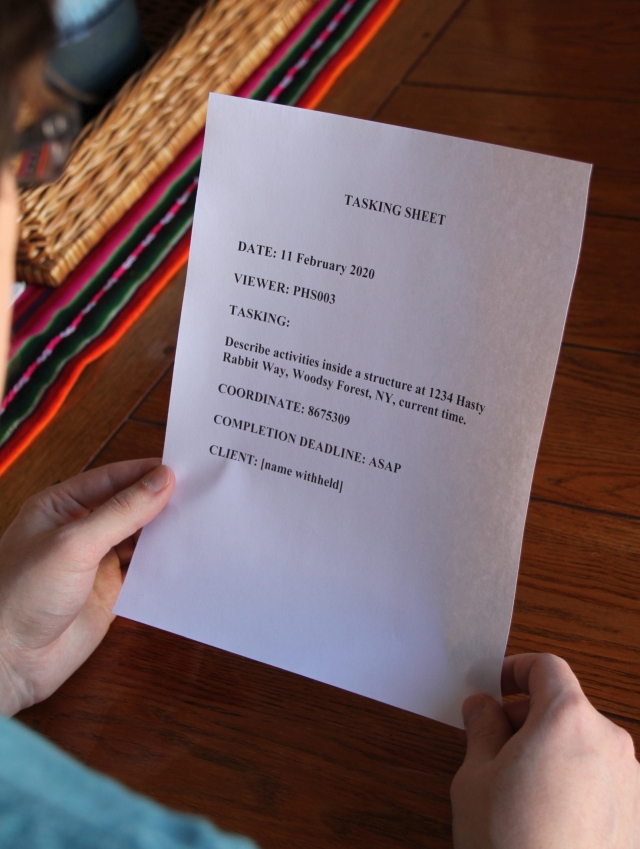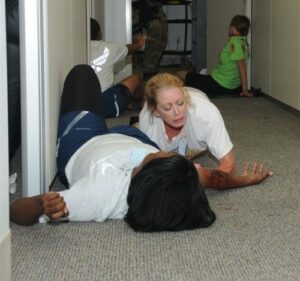Ever since remote viewing became a “thing” (and I’m talking 1971, not just 1995 or even 2020!) folks have wanted to kick the tires and take it out for a test drive. But that brings problems with it. Here is one: If you become a remote viewer, no matter what skill level you ultimately reach, someone will ask you to remote view a target for them.1
Remember that in a real remote viewing task, the viewer must be “blind” to the target. In other words, the viewer has to be able to trust the person doing the tasking. What do I mean?
First, let’s understand the roles in a remote viewing session. Obviously, the main player is the remote viewer her/himself. Without the remote viewer, nothing happens. But there is at least one, and potentially two (or sometimes more) others involved. In the classic model, the remote viewer has the assistance of a monitor (also called “interviewer” in the earlier scientific literature). This person assists with the session in a number of valuable ways (which I won’t list here).
In a training setting the monitor may be aware of what the target is. But in all other remote viewing environments (operations, scientific research, investing, etc.) if there is monitor involved, he or she should almost always also be “blind”—which means, should know nothing about the intended target. On the other hand, in every situation the viewer should be blind. Remote viewing can be done without a monitor’s assistance (this is called “solo” remote viewing). But there is one additional person who must be part of the process.

In nearly every remote viewing situation, you need a “tasker.” Taskers play the important role of deciding what target the remote viewer will view, and how the viewer will be “tasked” with the assignment. By definition, the tasker cannot be “blind” to the target, so the general rule (except in the training environment) is that the tasker should have no direct interaction with the viewer prior to or during the actual remote viewing session. The reason for this is to avoid the tasker inadvertently communicating information to the viewer that does not come via extrasensory perception.
There are at least six kinds of taskers;
1) Experienced, well qualified taskers who know exactly what sorts of targets to provide for the various kinds of remote viewing work, and how to task them.
2) Novice taskers, who are just learning the process and are (naturally) often insufficiently knowledgeable about targets and tasking.
3) People who want to test some unwitting viewer to see if remote viewing actually works. These sorts seldom know what kinds of targets are appropriate for remote viewing, and usually have no clue how tasking is properly done. Their ignorance may in fact lead to a failed remote viewing effort, defeating their own intended purpose.
4) Those who believe in remote viewing but don’t know a lot about it, yet think they do. They are motivated by curiosity to see others remote view targets they themselves come up with.
5) Those who have an agenda—a target or set of targets they want remote viewed for specific reasons. Often such targets are esoteric (e.g., sensational or without feedback or without provable ground truth—examples are UFO events or conspiracy theories) or involve highly emotional elements, such as murders or other significant crimes. (This category of tasker and the one previously described often overlap.) In most cases, these sorts of taskers also have a weak grasp on how remote viewing taskings should be done.
6) Skeptics, who are sure remote viewing is fake and want to trap a remote viewer into proving it by persuading the viewer to do a session that the skeptic is sure will fail.
Obviously, the best and most desirable taskers are those in the first category. And, since every tasker has to learn how to do it, the second category can also provide appropriate taskings, as long as they vet what they offer with an experienced tasker first. Just as obviously, one should be very careful when doing targets for anyone in the last four categories—if you choose to work with them at all.
There are a number of reasons for this. Taskers in the last four categories almost never know what they’re doing but often think they do. (Recent research shows that the incompetent individuals are almost always the ones who are most likely to believe that they are competent.) With very little introduction to or study of the remote viewing process, they bring an overwhelming—and largely unjustified—sense of confidence to their taskings. In almost all cases, the targets they propose are trivial or inappropriate for remote viewing.
Here’s just one example. Many remote viewers of varying degrees of experience and ability have been confronted with this challenge: “What do I have on the top of my desk?” (or refrigerator, or fireplace mantle, or what am I doing, or wearing, etc.).
There are several things wrong with this “test.”

Multiple possibilities. Though the challenger may be thinking of only the green mug in the upper right hand corner, there are frequently multiple other objects present, such as pens, books, a lamp, their cat—or any other random object in addition to what they have in mind. If the viewer describes a pen, then he or she has “failed” because “every desk has a pen on it!” And indeed, that is largely true. By specifying a desk (or other location) the would-be tasker adds suggestive cues that infect the viewer’s mind with additional sources of noise that confuse the signal.

Tricky Tasking. Remember, there is no control over the tasker-end of the remote viewing attempt. The viewer is at the tasker’s mercy, and can only trust that there actually is something on the desk. Inexperienced challengers are notorious for placing nothing on the desk (or in the drawer or in the envelope, or whatever), and then expecting the viewer to discover that there is “nothing there.” But this is a dishonest and unfair test. The viewer assumes that there will be something there because the self-proclaimed tasker implies this by asking what is there. The result is that, when finding nothing, the viewer’s subconscious mind may make something up to satisfy the tasker’s request. Often the tasker then criticizes the viewer for “failing”—even though the tasker is the real source of the failure.

Tasker Dishonesty. A further problem is the viewer has to trust the tasker to be honest. As I mentioned, not a few of these kinds of taskers are actually undisclosed skeptics who are trying to embarrass remote viewers. Some of them might be so invested in not having a remote viewer turn out to be correct that even if the viewer is successful the tasker might claim that the target was actually something else and falsely accuse the viewer of failing. Since these taskings are usually set up over the Internet via a Facebook group, a chat room, messaging app, email, or etc., there is no way of verifying anything the tasker claims.

And here’s yet another potential pitfall: You, the viewer, may be letting yourself in for remote viewing a target that you would never consent to engage with if you could know about it in advance. Since you have to be blind to the target, then an unprincipled tasker could inflict almost anything on you. For example, it could be a gruesome, brutal murder in New Orleans; or a mass burial site with decaying corpses in Africa; or even the first sexual encounter between Bill Clinton and Monica Lewinsky (which years ago was actually tasked to a class of unwitting students). You could be expecting something benign, like a castle in Europe, or a soccer game in Brazil, or a mountain in the United States, and instead the target turns out to be something horrifying. You even run the risk of being exploited by an unscrupulous tasker to provide information that the tasker then intends to monetize, having you do the work, then cutting you out of the financial loop, none the wiser.
There are, of course, well-meaning amateur taskers. They want you to try to find a missing child or solve some other problem. Mind you, they aren’t asking you to find their own missing child. They want you to remote view someone else’s missing child—or a kidnap victim or whatever or whomever the news media has recently reported missing. They have no particular authority nor connection to the case, nor special channel to pass your results along to some law enforcement official. Stay away from these requests! As you can get a hint of by reading here, your work will almost certainly be wasted because the authorities don’t particularly welcome psychic input from random sources.
Since you, the viewer, must be blind to whatever the target may be, it’s easy to recognize the major problem: Knowing in advance which one of these categories a prospective tasker falls into. Is she in the first category—a competent, experienced tasker? Or is he a skeptic? Does she have an agenda? Or is he just starting out, and deserves a chance (with guidance from someone with more experience)?
My counsel is:
- Only accept remote viewing assignments from a tasker with whom you are familiar2, or
- From someone who has been endorsed by people whose judgment you are sure is good.
In other words, beware the “unknown” tasker, and only accept remote viewing missions from someone you have reason to trust to do right by you.
For suggestions on how to vet or evaluate a potential tasker, click here.
—————————
Footnotes
- Anyone who gives you a target is considered a “tasker.” There are two situations involving a tasker in which you may be involved as a remote viewer. One is when someone asks you to remote view a target. The other is when you ask someone to arrange a target for you to remote view. This article is only about those cases when you are asked by someone else.
- Even some well-known people in the remote viewing community—perhaps even some who are famous—may not be proficient taskers. If possible, you should try to vet anyone you may be thinking about working with.
